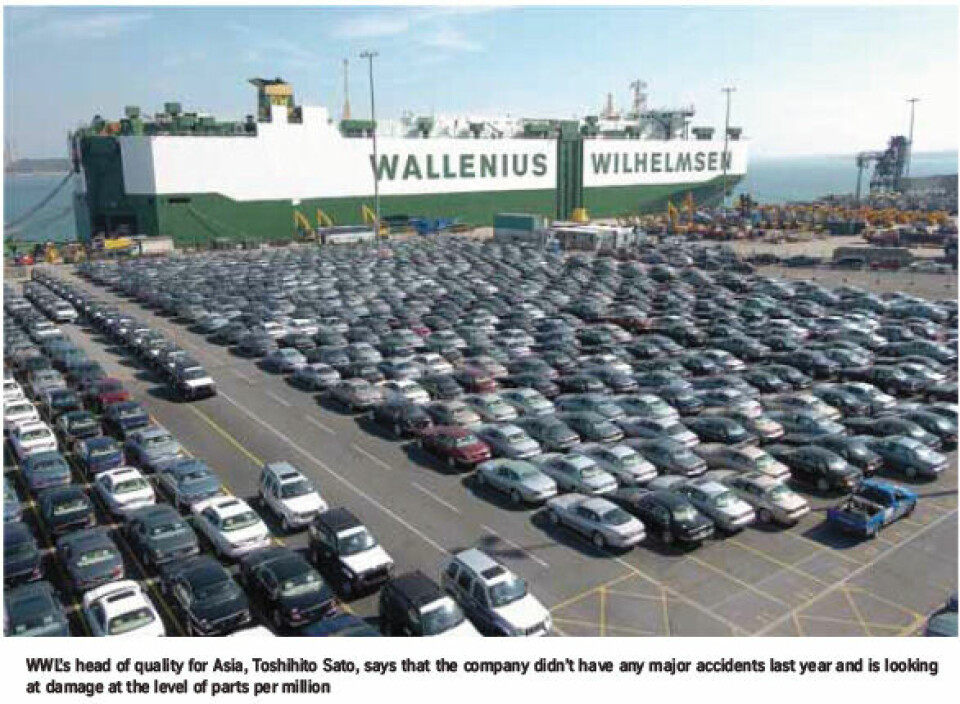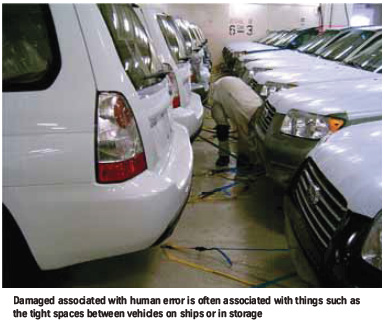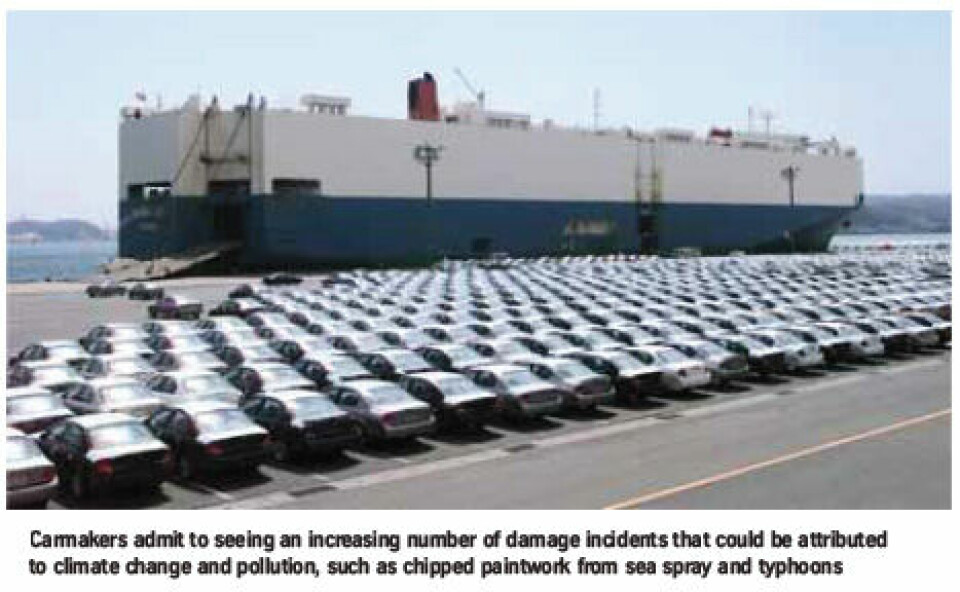Crazy for perfection

The Japanese have high expectations for product perfection from fruit to cars, which is one reason why its OEMs have some of the most rigorous damage prevention processes globally. William Ross reports.
Imagine an apple: its skin flawless, the colour perfect, meticulously wrapped, cradled in a little foam net and tastefully presented to the consumer. It is an image that stands out for many visitors to and observers of Japan, and is something of a symbol for a culture that values perfection.
“In 30 years of coming [to Japan], I’ve never seen anything but perfect fruit for sale–each neatly packaged one-by-one,” wrote Rick Seireeni in GreenBiz.com. “And when you buy the packaged fruit, they stick it in another package, and that goes in yet another bag. The Japanese are insane over perfection.” Spotless perfection, he goes on, “is the benchmark of daily life” in Japan. It doesn’t just extend to food items, either. Japanese consumers have come to expect that all products should not just be serviceable, but flawless. It is a traditional demand that has weathered both a decade-plus downturn of the economy and the trials of the March 2011 earthquake and tsunami.

It also doesn’t just extend to the premium side of the market. Japanese consumers are buying more budget items. Look at the success of the stylish yet low-cost Uniqlo clothing chain, or even the fact that today half of all Japanese are driving kei-class automobiles– affordable, economical vehicles with engine displacements no larger than 660cc. However, the move to more budget buying hasn’t meant that the purchases will be accepted with anything less than zero defects; no dings and no scratches.
That spells a challenge for Japanese carmakers in their home territory, with all six of the majors fighting for market share in this demanding, fussy market. Japan is home to one of the most competitive domestic markets in the world, with all six of Japan’s car companies in the global top 20, including four in the top ten. As big as they are, at home they have to continue to provide a better product just to hold on to their share–and it’s a market that has stagnated for the better part of a decade. That stiff domestic competition, though, has long been cited as precisely the reason why Japanese car manufacturers have succeeded on the world stage. The dedication to making what goes into the car as perfect as possible has been matched by the same persistent, step-by-step, ongoing drive to make sure that the whole thing stays flawless all the way to the consumer. No defects, no dings; not even the tiniest scratch.
On the surface cover, a global standard
What Japanese manufacturers do to prepare their cars for shipping appears, at least on the surface, no different than what every automobile manufacturer does around the world.

“There are no Suzuki exclusive actions we take,” says Yukihiko Inoue, in charge of international public relations for the company. “We just apply the guard film to the painted surfaces to protect from bird droppings, acid rain and that kind of thing.”
Low-density foam and films are applied on door edges, the steering wheel, in the foot well, on seats, bumpers, the hood roof and trunk, even in the depression under the door handles. “The protective material we use is standard around the world,” says Nissan spokesman Chris Keeffe. “We don’t just do this in Japan, but for every vehicle we ship everywhere in the world.”
As would be expected, all the companies and their logistics suppliers, have also instituted thorough inspection processes that cover the entire length of the outbound supply chain. Nissan, for example, makes use of third-party inspectors at various points in the supply chain, from factory departure, to unloading the ship and sometimes at a pre-delivery, centralised point. Suzuki also makes use of a central hub for inspections. “We have what’s called a nousei–a delivery and maintenance centre,” says Suzuki’s Inoue. “Automobiles sent from the factory always go to the nousei i centre first before being delivered to domestic dealers, which reduces the possibility of damaged automobiles being delivered. This is not exclusive to Suzuki, but a system shared by all of the Japanese manufacturers.”
Digging around the roots of damage
What does separate the Japanese in the damage and prevention process is perhaps what happens behind the scenes, in a methodical, detail-oriented approach, something like ‘Zen and the art of damage prevention’ (not just control). Anyone who has done business in Japan knows that you’re in for a lot of meetings before anything gets done. The concepts that have gained some global recognition are still dominant: these includes kaizen (continuous improvement) or nemawashi, which refers to ‘digging around the roots’ to discuss and examine every aspect of an issue, and building support before making a decision. There is also what the Japanese sometimes refer to as ‘wet’, or highly interpersonal relationships, compared to the ‘dry’, legal relationships of the West.
These aren’t just fad words that came and went with Japan’s rise in the 1980s and troubles of the 1990s. Everybody involved is part of the process and the organisation at the top always continues to press suppliers for more and more improvements. “Japanese companies definitely have a unique approach to damage protection,” says Toshihito Sato, head of cargo quality for Asia at shipping and logistics firm Wallenius Wilhelmsen Logistics (WWL). “You could say in a positive way that they’re very tough on suppliers, but you could also say that it’s…well, kind of strange!”
He explains that the Japanese view on controlling damage comes in the planning stage, rather than simply addressing it after the fact.

“For a lot of manufacturers around the world, problems like scratches are something that come up at the end of the logistics process, with a claim being made against the party who caused the damage,” Sato continues. “You follow the manual; if you don’t, then it’s no good and somebody has to pay. The Japanese approach is completely different. They really worry about the details at every stage of the process and how to prevent damage.” It’s not, he says, only about reacting to the current problem, but in trying to foresee issues before they occur. Sato is in a good position to see the differences. Japanese himself, he understands the domestic mentality and approach, but he also works for a European-based logistics firm that carries vehicles for all of the Japanese car companies, as well as for countless other manufacturers around the world. “Compared to what we see in other markets, most often damage casued by an actual accident involving human error is not the focus–the causes of damage today are not simple, but very complicated,” Sato says. “More often a problem involved with the tight spaces between vehicles on ships or in storage. Workers who don’t have their clothing fastened up properly cause small scratches to the vehicles–these are the kind of problems that we are seeing.”
The damapre meeting and kaizen katsudo
For Mitsubishi Motors, the process of improvement begins during what is called a damapre meeting–a word created by a typically Japanese abbreviation of the English words ‘damage’ and ‘prevention’. “We hold damapre meetings involving us, our insurance companies, the stevedores and others actually handling the vehicles, once every month,” says Tomo Nishina, general manager of the company’s export operations department. “At the meetings we review progress and set out new targets.” All of the Japanese manufacturers hold similar sessions to examine and create solutions for damage, Sato says. “Toyota meets monthly as well, where they set the targets for change and get input from third-party companies like the insurance firms. Toyota in particular has put out some very strict, demanding guidelines.”
Nishina says that there have been some improvements in the way that logistics companies and carmakers work together to improve damage prevention. “The cargo handling companies used to act independently in the past to try and improve,” he says. “But we’re seeing more and more that they are joining together in kaizen katsudo– activities aimed at improving damage control. As things have gotten more demanding, they have just found that it’s a lot more effective to work together on the problems.” The meetings are not simply for executives to come up with solutions to be handed down. “We spend a lot of time in the training of the cargo handling companies we work with,” Sato says. “At the meetings we also spend a lot of time analysing where damage is happening, but then also come up with ways to get the information to all the workers.”
Suzuki’s Inoue and Mitsubishi’s Nishina likewise note that, acting on the results of the dampare-type meetings, information is actively sent to suppliers and training sessions are held to put damage control into action.
That process of sharing information, Nishina says, is working. “Damage has been greatly reduced over the years,” he says. “We’re focusing on reducing damage in particular markets. We don’t really vary our approach to damage prevention whether we’re shipping domestically or internationally–we don’t vary the level of quality we provide anywhere.” Nevertheless, Nishina identifies several ports where it has faced more challenges for damage than elsewhere. “We’re finding, for example, that our port in Jacksonville, Florida has been a tough one for us, as has one in Spain. It’s hard to identify exactly why and where problems are happening, but we’re working on it.”
A lower rate of damage
It is not easy to offer an accurate assessment of the typical rate of transport damages in global markets. In Europe, inspection specialist Sevatas has typically estimated a level of 3-5% damage of some kind, although depending on transport mode and routes, many carmakers report lower figures. In growing markets such as India and China, visibility on damage rates is notoriously difficult to obtain.
Japanese manufacturers insist that their levels are far below 3%. For example, Nissan spokesman Chris Keeffe says that, while he cannot reveal precise figures, the company considers its level of damage in transit to be below the industry standard. Suzuki also sees itself well below this level. “As far as domestic transportation is concerned, we don’t see damage at the 3% level,” agrees Inoue. “We believe the percentage is much smaller.” Nishina adds that even in its more challenging ports, the damage that Mitsubishi is seeing is almost entirely paint damage during moves on and off vessels–and, he says, at levels of below 1% of all vehicles. “We are trying to figure out how to go below levels of 0.6% and 0.5%,” he says. “Last year we didn’t have even one major accident.” reveals WWL’s Sato. “When we survey damage, it isn’t even 1%– but now it is in the area of small paint scratches that the manufacturers are trying to improve even more.” Sato says that cargo handling and stevedoring has reached such a high level that the damage of vehicles is on a productivity scale that is close to what is seen for manufacturing. “We’re in a place where we’re talking about damage at the level of parts per million, not percentages,” says Sato. “So the manufactures look at our loading and unloading activities, and they understand that the quality is very high. But now they are looking at the more detailed level–such as the scratches that I already mentioned–as the next place to find improvements in reducing damage. It is tough.”
The effects of climate change
Damage, of course will always happen: hail will fall from the skies and the seas are still salty. The world is a constantly changing place and humans are adding to the challenges of keeping a car pristine until it gets to its new owner. Japanese OEMs believe, for example, that climate change is having an impact on damage patterns.
Inoue of Suzuki says climate change has increased damage on some areas of paintwork, “mostly chipping of paint by stones due to high winds, and sea spray from stronger typhoons”. Nissan’s Keeffe says that his company also sees some damage resulting from environmental changes and pollution. “We do see more problems with airborne pollution materials like coal and iron dust, which encourage corrosion,” says Keefe. “We don’t really see a change in damage coming as we move into more manufacturing internationally, but we do with climate change.” He adds that the company has been checking for a particularly nasty form of pollution since the March 11th disaster in the Tohoku region.
“We started doing radiation checks within five days of the earthquake and we’ve continued to do so ever since.” Fortunately, no radiation has been found beyond normal background levels, he says, a statement also backed up by a release by the Japan Automobile Manufacturers Association–something that has certainly helped to ease the fears of consumers around the globe. With Nissan exporting some 50% of all cars it produces in Japan, this has been an important, if unusual, damage control process.
Need something else besides perfection
Even for Japan, though, car manufacturing and distribution is not just about making something that is perfect. Perfection has its price, and Japanese firms struggling against a high yen admit that engineering-in perfect technology may be impossible. There is even a suggestion that some might be focused on certain aspects of quality and perfection to the extent that they are missing the bigger picture. “Japanese manufacturers tend to go for the very highend of things,” says a senior executive at a Japanese truck manufacturer who asked not to be named. “There is a feeling that things have to be 100% to be good enough. It’s an old tradition. No errors, no compromise on quality. But is this really the best way in a competitive world? If you’re making something that’s perfect but it’s too expensive, then that’s not a successful product.”
However, in the area of predicting, preventing and controlling damage, the unique approach taken by Japanese carmakers and their logistics service providers is likely to continue to benefit them in the future. Presenting a consumer with a perfect car from the very start not only means increased consumer satisfaction, but also reduced insurance and repair costs. That can only help in a competitive and highcost world for Japan’s carmakers.





